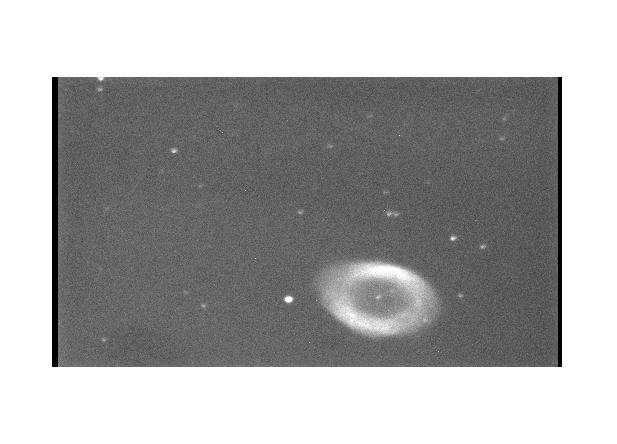
A 60 second look at the Ring Nebula while adjusting tracking.Abstract: Producing and analyzing CCD images at the Hamilton College Observatory, Heather Parker’07, Peter Millet, 5/22-8/28, 2006Astronomical images are made using CCD cameras because they are sensitive, linear, and provide a digital record that can be readily analyzed, manipulated, and transmitted using the computer. We have installed a SONY ICX055 CCD based camera (500 pixels by 290 pixels) at the prime focus of the 12” f/10 fork-mounted Schmidt-Cassegrain telescope in the Hamilton observatory. The field width of 5.5' x 4.1' demands a minimum tracking accuracy that can only be achieved by considerable tuning of the telescope system. Our tracking accuracy is largely determined by mount alignment with Earth’s axis of rotation and by the mechanical quality of the worm and gear in the sidereal drive. The computer controlled mount has an observer-trainable periodic-error-correction (PEC) function to reduce the effect of variations in the worm-gear action. To minimize backlash we have thrown the fork out of balance by adding weight to the eastern tine. Using the camera in focus mode (.5 sec. exposures) we manually provide corrections to steady the position of a star when training the PEC. Examination of the resulting training curve suggests the need for a small alteration in the overall tracking rate. This requires further study to achieve optimum adjustment since the PEC and the overall rate are interdependent. We have also experimented with auto-guiding software that delivers correcting pulses to the mount drive to prevent motion of a star image over the surface of the CCD but, thus far, this software has proven unable to control the telescope.To correct images for artifacts introduced by the CCD camera, and to acquire tools for subsequent analysis, we have been learning Unix based software known as the “Image Reduction and Analysis Facility” or IRAF. Using the Unix-like Darwin available on the iMac as a platform, we have installed this software and studied how to display and perform various operations on images we obtained this summer. Among the tasks we have undertaken (and continue to learn about) through use of IRAF are:
IRAF is written and supported by the IRAF programming group at the National Optical Astronomy Observatories (NOAO) in Tucson, Arizona. NOAO is operated by the Association of Universities for Research in Astronomy (AURA), Inc. under cooperative agreement with the National Science Foundation.
|